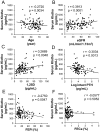A decreased level of serum soluble Klotho is an independent biomarker associated with arterial stiffness in patients with chronic kidney disease
- PMID: 23431388
- PMCID: PMC3576368
- DOI: 10.1371/journal.pone.0056695
A decreased level of serum soluble Klotho is an independent biomarker associated with arterial stiffness in patients with chronic kidney disease
Abstract
Background: Klotho was originally identified in a mutant mouse strain unable to express the gene that consequently showed shortened life spans. In humans, low serum Klotho levels are related to the prevalence of cardiovascular diseases in community-dwelling adults. However, it is unclear whether the serum Klotho levels are associated with signs of vascular dysfunction such as arterial stiffness, a major determinant of prognosis, in human subjects with chronic kidney disease (CKD).
Methods: We determined the levels of serum soluble Klotho in 114 patients with CKD using ELISA and investigated the relationship between the level of Klotho and markers of CKD-mineral and bone disorder (CKD-MBD) and various types of vascular dysfunction, including flow-mediated dilatation, a marker of endothelial dysfunction, ankle-brachial pulse wave velocity (baPWV), a marker of arterial stiffness, intima-media thickness (IMT), a marker of atherosclerosis, and the aortic calcification index (ACI), a marker of vascular calcification.
Results: The serum Klotho level significantly correlated with the 1,25-dihydroxyvitamin D level and inversely correlated with the parathyroid hormone level and the fractional excretion of phosphate. There were significant decreases in serum Klotho in patients with arterial stiffness defined as baPWV≥1400 cm/sec, atherosclerosis defined as maximum IMT≥1.1 mm and vascular calcification scores of ACI>0%. The serum Klotho level was a significant determinant of arterial stiffness, but not endothelial dysfunction, atherosclerosis or vascular calcification, in the multivariate analysis in either metabolic model, the CKD model or the CKD-MBD model. The adjusted odds ratio of serum Klotho for the baPWV was 0.60 (p = 0.0075).
Conclusions: Decreases in the serum soluble Klotho levels are independently associated with signs of vascular dysfunction such as arterial stiffness in patients with CKD. Further research exploring whether therapeutic approaches to maintain or elevate the Klotho level could improve arterial stiffness in CKD patients is warranted.
Conflict of interest statement
Figures



Similar articles
-
The association between soluble klotho and cardiovascular parameters in chronic kidney disease: results from the KNOW-CKD study.BMC Nephrol. 2018 Mar 5;19(1):51. doi: 10.1186/s12882-018-0851-3. BMC Nephrol. 2018. PMID: 29506503 Free PMC article. Clinical Trial.
-
[Role of the morphogenetic proteins FGF-23 and Klotho and the glycoprotein sclerostin in the assessment of the risk of cardiovascular diseases and the prognosis of chronic kidney disease].Ter Arkh. 2015;87(6):10-16. doi: 10.17116/terarkh201587610-16. Ter Arkh. 2015. PMID: 26281189 Russian.
-
Progression of arterial stiffness is associated with changes in bone mineral markers in advanced CKD.BMC Nephrol. 2017 Sep 4;18(1):281. doi: 10.1186/s12882-017-0705-4. BMC Nephrol. 2017. PMID: 28870151 Free PMC article.
-
[Vascular Calcification - Pathological Mechanism and Clinical Application - . Vascular calcification in chronic kidney disease-mineral and bone disorder (CKD-MBD)].Clin Calcium. 2015 May;25(5):645-53. Clin Calcium. 2015. PMID: 25926567 Review. Japanese.
-
FGF23 and Klotho in chronic kidney disease.Curr Opin Nephrol Hypertens. 2013 Jul;22(4):397-404. doi: 10.1097/MNH.0b013e32836213ee. Curr Opin Nephrol Hypertens. 2013. PMID: 23666415 Review.
Cited by
-
Association between serum Klotho levels and estimated pulse wave velocity in postmenopausal women: a cross-sectional study of NHANES 2007-2016.Front Endocrinol (Lausanne). 2024 Sep 12;15:1471548. doi: 10.3389/fendo.2024.1471548. eCollection 2024. Front Endocrinol (Lausanne). 2024. PMID: 39329104 Free PMC article.
-
Longitudinal FGF23 and Klotho axis characterization in children treated with chronic peritoneal dialysis.Clin Kidney J. 2014 Oct;7(5):457-63. doi: 10.1093/ckj/sfu074. Epub 2014 Aug 8. Clin Kidney J. 2014. PMID: 25878777 Free PMC article.
-
Urine 5MedC, a Marker of DNA Methylation, in the Progression of Chronic Kidney Disease.Dis Markers. 2019 Jul 1;2019:5432453. doi: 10.1155/2019/5432453. eCollection 2019. Dis Markers. 2019. PMID: 31354889 Free PMC article.
-
Plasma Klotho concentrations predict functional outcome at three months after acute ischemic stroke patients.Ann Med. 2019 May-Jun;51(3-4):262-269. doi: 10.1080/07853890.2019.1617434. Epub 2019 Jun 5. Ann Med. 2019. PMID: 31070492 Free PMC article.
-
Relationship between plasma S-Klotho and cardiometabolic risk in sedentary adults.Aging (Albany NY). 2020 Jan 20;12(3):2698-2710. doi: 10.18632/aging.102771. Epub 2020 Jan 20. Aging (Albany NY). 2020. PMID: 31958773 Free PMC article.
References
-
- Sarnak MJ, Levey AS, Schoolwerth AC, Coresh J, Culleton B, et al. (2003) Kidney disease as a risk factor for development of cardiovascular disease: a statement from the American Heart Association Councils on Kidney in Cardiovascular Disease, High Blood Pressure Research, Clinical Cardiology, and Epidemiology and Prevention. Circulation 108: 2154–2169. - PubMed
-
- Go AS, Chertow GM, Fan D, McCulloch CE, Hsu CY (2004) Chronic kidney disease and the risks of death, cardiovascular events, and hospitalization. N Engl J Med 351: 1296–1305. - PubMed
-
- Moe S, Drüeke T, Cunningham J, Goodman W, Martin K, et al. (2006) Definition, evaluation, and classification of renal osteodystrophy: A position statement from Kidney Disease: Improving Global Outcomes (KDIGO). Kidney Int 69: 1945–1953. - PubMed
-
- KDIGO clinical practice guideline for the diagnosis, evaluation, prevention, and treatment of Chronic Kidney Disease-Mineral and Bone Disorder (CKD-MBD). Kidney Int Suppl: S1–130. - PubMed
MeSH terms
Substances
LinkOut - more resources
Full Text Sources
Other Literature Sources
Medical

